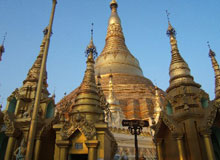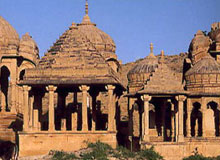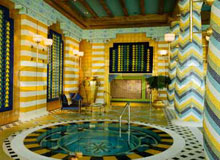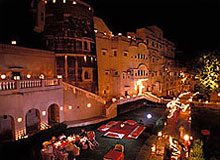|
Day 01 : Departure From Home Country : Arrive Delhi
 Departure from Home Country, Late evening, On arrival at Delhi, our representative will meet at Airport TRADITIONAL WELCOME �Namaste" gesture-Two hands joined together in welcome-will greet them and this greeting encapsulates the warmth, hospitality and culture that makes a journey to India so memorable and transfer to Hotel. Overnight stay
Departure from Home Country, Late evening, On arrival at Delhi, our representative will meet at Airport TRADITIONAL WELCOME �Namaste" gesture-Two hands joined together in welcome-will greet them and this greeting encapsulates the warmth, hospitality and culture that makes a journey to India so memorable and transfer to Hotel. Overnight stay
Day 02 : Delhi - Agra
After Breakfast start your sightseeing with Old City called Old Delhi and after that Lutyens city, an expression of Empire.
Drive past the imposing 15th century Red Fort (from Outside) and Chandni Chowk � Since many of the monuments are closed for restoration we suggest not spending the time to go in. It is still worth driving by it. But check with your local guide what the latest is and decide accordingly.
A ride on the wild side! (Approx. 1 hr) explore the many lanes and narrow alleyways through Old Delhi. Please Note that you will be entering extremely narrow and crowded lanes, filled with people, cows, and every kind of foot traffic. Expect to be jostled and stared at.
This is not for the faint of heart, but is an exciting wild ride. Meet your escort for your foray into the small by-lanes of Old Delhi, near the Red Fort where your car will wait for your return. You will board two cycle rickshaws (Pedi cab).
The tour will be by Rickshaw and will be adjusted depending on the traffic. Among the many sights you will visit in and around Chandni Chowk are �
Dariba Kalan� A lane of very old shops � Here old and new silver and gold jewelry is sold by weight from jewelers whose forefathers served the emperors. Ancient perfumeries sell lotus and rose attar (distilled essence)
Kinari Bazaar � Which glitters with braid and gilt, turbans, fake swords, rupee note garlands and face masks of Gods and warriors
Jama Masjid : One of the greatest mosques built by the Mughals. There is so much congestion around it that you can decide if you want to get off here or not
You will drive through the Diplomatic Enclave, the Maidan lined with palaces & Government buildings to the Presidential Palace, India Gate, and other monuments designed by Sir Edwin Lutyens (open daily).
|
|
|
Typical Indian Lunch at city Restaurant at Chor Bizarre. which translates as 'thieves market'. All kinds of wares find their way here. From furniture to fabrics, pearls to periodicals, crystal to cutlery�With antique tables as counters for coal irons and grandfather clocks jostling with stereos, colourful street food vendors, bangle sellers and old jewellery sharing space with auto parts - the Chor Bazaar captures the spirit of India..
After Lunch You will drive through Humayun tomb to Agra,
Humayun's Tomb
The most important early Mughal monument in Delhi, it is an outstanding landmark in the development of Mughal style. The red sandstone and marble garden tomb set the pattern for Mughal mausoleums that culminated in the Taj at Agra. Nine years after his death,
the most important early Mughal monument in Delhi was built by his senior widow,
Haji Begum. An outstanding landmark in the development of Mughal style, the red sandstone and marble garden tomb set the pattern for Mughal mausoleums that culminated in the Taj Mahal at Agra. An ornamental gateway piercing a high wall leads to a formal garden, where the domed memorial is set on a broad podium. It was constructed 1565-71 to designs by the Persian architect Mirak Mirza Ghiyas who applied the spatial concepts of Timurid and Safavid architecture to local architectural forms and materials. He also introduced the important Mughal double dome whose two skins resolve the problem of achieving a lofty exterior while keeping the internal proportions in balance. Among the other Mughal royals buried here is Dara Sikoh, Shah Jahan's favorite son. Outside the gateway are nobleman Isa Khan's octagonal Lodi-style tomb, and a row of dormitories, probably the living quarters of the Persian craftsmen working on the mausoleum.-
After that drive to Agra (approximately 220 kms / 4 � 5 hrs). The Highway to Agra has recently been modernized and is a four lane divided highway with a number of midway restaurants for refreshments to unwind you.
The First landmark on the horizon of Agra city is the serene monument of Sikandra � the mausoleum of Mughal Emperor Akbar which he himself started constructing but was completed in 1613 during the reign of Jehangir who made some modifications to its original design and added the top terrace with marble cloisters containing a false grave of the emperor.
Later continue on to Agra and checking at Hotel. Upon arrival check in to hotel.Overnight stay

Day 03 : Agra
After breakfast, drive towards Tajmahal . visit to the TAJ MAHAL, (Taj Mahal is closed on Friday ) One of the seven wonders of the world, built by the Moghul Emperor Shahjehan, this beautiful mausoleum is built of pure white marble and is an architectural marvel. Built in the memory of his beloved queen Mumtaz Mahal the construction of this architectural marvel took over 22 years and required almost 20000 laborers. Stainless white marble was excavated from the mines at Makrana, sandstone was brought from Fatehpur Sikri and precious and semi precious stones were chosen from across the globe. The building was conceived as a garden tomb with the mausoleum rising at the far end of the complex with the river Yamuna flowing below.
Beneath the dome are the cenotaphs of Mumtaz Mahal and Shah Jehan. Reaching a height of almost 75 metres, the Taj Mahal with its luminous exterior is a monument of many moods with light effects playing different roles with the gradual passage of the day.
After visiting the Taj Mahal continue the sightseeing among the other important landmarks of the Moghul era are the Red Fort, built by Emperor Akbar over the years 1565 � 1573 with its maze of courtyards, mosques, and private chambers which reflect the skills of the ancient Indian architects and artisans. Most of the buildings originally built by Akbar were destroyed and were replaced by his grandson Shah Jehan. The only surviving structure from Akbar�s period apart from the solid sand stone ramparts and the gateway is the Jehangir Mahal. It is the biggest private residence in the complex and its architecture indicates strong influences from Hindu overtones. The Diwan-I-Khas which is the exclusive hall of private audience was built by Shah Jehan. It is here that the famous Takht � E � Taus was kept before it was moved to Delhi. Nearby are the various buildings which were built by Shah Jehan including the Khas Mahal, The Jasmine Towers, the Octagonal Tower, the Sheesh Mahal, and the Hamam�s. Ironically it was within these apartments that Shah Jehan spent his last years when he was imprisoned by his son Aurangzeb.
After that return to Hotel for Lunch. Later visit Itmad-Ud-Daulah's Tomb - This tomb belongs to the father of Nur Jahan, Ghias-ud-Din Beg. He was the Wajir or the Chief Minister of Emperor Jehangir. This white marble tomb was built by Nur Jahan between 1622 and 1628. Later free day for shopping. Overnight stay.
Day 04 : Agra - Jaipur
After Breakfast drive to Jaipur ( approxiamate 245 Kms 5 � 6 Hrs ) enroute visiting the deserted capital of the Mughal empire at Fatehpur Sikri. Located approximately 36 kms / 1 hours drive away the town was built by the Mughal Emperor, Akbar who had planned this city as his capital but shortage of water compelled him to abandon the city. After this within 20 years, the capital of Mughals was shifted to Lahore.
Fatehpur Sikri was built during 1571 and 1585. Today this ghost city has a population of about 30,000. This deserted city has retained many of the old structures, because of the efforts of the Archaeological department .
It is one of the finest examples of Mughal architectural splendour at its height. Though the city is in ruins, it is a place to visit if one comes to Agra. But in real terms Fatehpur Sikri is a place where one should spend some time. The sunset over the ruins is a sight to cherish.
It is perhaps the best example of the culmination of Hindu and Muslim architecture in India. The great Mosque is said to be a copy of the mosque in Mecca and has designs, derived from the Persian & Hindu architecture.
Lunch on the way. Later continue on to Jaipur. Upon arrival check in at the Hotel.
Dinner at Hotel and overnight.
Day 05 : Jaipur
 After breakfast Visit Amber fort and ride up to the fort on decorated elephant back or by Jeep. The Amber palace was built by the Kachhwajas when they rose in eminence and power under the Mughals. Man Singh I built it in a style to rival Mughal grandeur and opulence. Diwan-e-Aam has a double row of columns with elephant-head brackets, which had to be covered with stucco to escape the jealous eye of Jehangir. Ganesh Pol, entrance portal to inner palaces, is the most magnificent portal in Rajasthan, covered with elegant frescoes and crowned with pavilions carrying fascinating jail screens. Jai Mandir has millions of glass pieces on stucco. The same scheme of ornamentation is repeated at
After breakfast Visit Amber fort and ride up to the fort on decorated elephant back or by Jeep. The Amber palace was built by the Kachhwajas when they rose in eminence and power under the Mughals. Man Singh I built it in a style to rival Mughal grandeur and opulence. Diwan-e-Aam has a double row of columns with elephant-head brackets, which had to be covered with stucco to escape the jealous eye of Jehangir. Ganesh Pol, entrance portal to inner palaces, is the most magnificent portal in Rajasthan, covered with elegant frescoes and crowned with pavilions carrying fascinating jail screens. Jai Mandir has millions of glass pieces on stucco. The same scheme of ornamentation is repeated at
Diwan-e-Khas, also built by Mirza Raja Singh. Sheesh Mahal, core of this structure, is the pinnacle of the art of ornamentation with glass. Ramparts built within walls take you to the Janana palace built by the Man Singh-I. A Baradari stands at the center of the spectacular courtyard surrounded by ladies apartments and frescoes depicting Krishna-Lila scenes. Amber is undoubtedly the grandest achievement of Rajput architecture.
Later return for Lunch at city Restaurant.
Afternoon sightseeing of Jaipur city sightseeing includes the City Palace - Sprout in the middle of the Great historical city Jaipur lies this unique palace offering a wide range of experiences. The battle-scarred walls & turrets remind of the glorious past. In the heart of the old city is former royal residence built in a blend of the Rajasthani and Mughal styles (open until 1700 hours).
City Palace is furnished and decorated with priceless works of art that form part of the Royal Collection, one of the major art collections in the world today. Its imperial Rooms form the nucleus of the working Palace and are used regularly by His highness and members of the Royal family.
Costume museum - The Textile and Costume section of the City Palace has a fine collection of the fine loom, woven and embroidered Kashmir shawls, Kimkhabs (brocades) from Surat, Banaras and Aurangabad, the large variety of hand block prints from Sanganer and other localities, the Bandhej (tie and dye) pieces from Jaipur, Muslins from Dhaka, old embroidered rugs and tent-hangings, delicately embroidered and appliqu� rosary-bags, caps, Rath (a type of carriage) covers, Thal-Poshes (dish covers) royal paraphernalia, exquisitely embroidered costumes worn by the different Maharajas and their consorts, typical Rajasthani costumes used over the ages and delicate Zari (gold thread) and Gota (gold or silver frill) works, for which Jaipur has always been very famous. The most noteworthy exhibit is perhaps the unusually large brocaded Jama (a robe) and pajama of Maharaja Madho Singh I. The Maharaja was no doubt of gigantic physical proportions. There is an equally large white muslin pleated Jama and a huge silk covered Atamsukh worn by him, which is on display in the museum.
Continue your visit to �Jantar Mantar�, the astronomical observatory - At the entrance to the City Palace is Jantar Mantar, the 'Yantralaya' of Sawai Jai Singh II, the last great classical astronomer in India. The modernistic structures known as 'Yantras' are the unique creations of this astronomer-king designed by him and built by experts to observe the movements of sun, moon, planets and the stars. This is the largest of five observatories founded by him in 1716 AD. The others are at Delhi, Ujjain, Mathura & Varanasi. Its massive masonry instruments are of an extraordinary precision & can still be used to measure local time, the sun's declination, azimuth & altitude, the declination of fixed stars & planets & also to determine the time of an eclipse of the sun.
Then comes Jaipur�s signature building, the Hawa Mahal, a multi layered palace, was built by Maharaja Sawai Jai Singh II. Famous for it's beehive like structure, the Mahal is interplay of red and pink sand stone, carefully and painstakingly outlined with white borders and motifs. The palaces and forts of yesteryears, which were witness to the royal processions and splendours, are now living monuments, accepted quite naturally into the lifestyle of the people of the "Pink City".
Overnight stay.
Day 06 : Jaipur � Mandawa
 After breakfast drive to Mandawa ( 175 Kms -03 to 04 Hours Drive) located In the heart of the Shekhawati region of Rajasthan lies the beautiful small town Mandawa, known throughout the state for its forts and havelis. The structures of this place reminds one of the cultural and social hotspot this place used to be in the bygone era.
After breakfast drive to Mandawa ( 175 Kms -03 to 04 Hours Drive) located In the heart of the Shekhawati region of Rajasthan lies the beautiful small town Mandawa, known throughout the state for its forts and havelis. The structures of this place reminds one of the cultural and social hotspot this place used to be in the bygone era.
Mandawa is situated in the north Indian state of Rajasthan around 190 km off Jaipur, the capital of the state. The town lies between latitude 28.06� in the north and longitude 75.20� in the east. The fort town of Mandawa is well connected with the other places in region through a good network of roads.
The compact and busy little market town of Mandawa was settled and fortified in 18th century by the dominant merchant families of the region. The wealthy businessmen of the village constructed many havelis and baolis with colored painting adorning their walls. Later on, with the migration of these merchant families, their old settlements remained in total obscurity with no one to look after them. Despite the time lapse and ignorance about these visual and architectural extravaganzas, their attraction did not fade and today they are some of the major attractions for the tourists visiting Rajasthan.
Mandawa provides the visitors with a sense of discovery at every turn; battlements that offer spectacular views of the town below, a whimsical peacock weather van, and an arched window that overlooks the verdant garden visited by peacocks. Most importantly, the fact that no two rooms are alike in the palace here. In the zenana or women's quarters, one room offers antique murals, another has a marble fountain, and the turret room boasts of walls that are seven feet thick. Looking out from the window of the turret room, it is easy to imagine the marauding bandits that once roamed freely here. Little wonder then that the family crest contains the motto, 'Veer Bhogya Vasundhara', which translates into 'the brave shall inherit the earth'.
Founded in the 18th century, the medieval fort of Mandawa dominates the town with a painted arched gateway adorned with Lord Krishna and his cows. The Chokhani and Ladia havelis and the street with Saraf havelis are some of the splendid examples of this region's havelis.
The Binsidhar Newatia Haveli has some curious paintings on its outer eastern wall-a boy using a telephone, and a European woman in a car driven by a chauffeur. The Gulab Rai Ladia Haveli has some defaced erotic images.
Lunch at Mandawa. Later sightseeing of Mandawa visit Haveli and Open-air painting.
Overnight stay.
Day 07 : Mandawa � Delhi
After breakfast drive to Delhi (270 Kms - 07 Hours Drive) enroute stop in small village fro photography. On arrival Delhi Farewell Dinner at nearest International airport, After dinner assistance and transfer to International airport to board flight for onward destinations.
Day 08 : Depart For Home Country
Flight for onward destinations
|